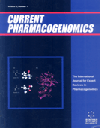- Home
- A-Z Publications
- Current Pharmacogenomics
- Previous Issues
- Volume 2, Issue 3, 2004
Current Pharmacogenomics - Volume 2, Issue 3, 2004
Volume 2, Issue 3, 2004
-
-
Pharmacogenomics of Arylamine N-acetyltransferase
More LessAuthors: Adeel Mushtaq, Matthew Anderton and Valerie CornishThe arylamine N-acetyltransferases (NATs) are a unique family of enzymes that catalyse the transfer of an acetyl group from acetyl CoA to the terminal nitrogen of hydrazine and arylamine xenobiotics. They have well characterised roles in drug detoxification and carcinogen activation and NAT homologues are present in numerous species from bacteria to humans. The importance of human NAT in xenobiotic metabolism is Read More
-
-
-
From Genomic Imprinting to Developmental Physiology: Identifying Stepping Stones
More LessAuthors: Bernard Dan, Stewart G. Boyd and Guy CheronGenomic imprinting is a process that determines differential expression of genes according to their parental origin. Most imprinted genes play roles in growth, development and tumour suppression. Angelman syndrome is one of the most studied human diseases related to a gene that is expressed on the maternal chromosome only (at least in certain brain cells). It is caused by inactivation of the UBE3A gene in the brain Read More
-
-
-
Pharmacogenomics of Cytochrome P450 Enzymes in Tumours
More LessAuthors: Diane Downie, Patrick H. Rooney, Morag C.E. McFadyen and Graeme I. MurrayThe field of pharmacogenomics is continuously progressing with the development and availability of molecular biotechnologies such as protein and DNA chips. These applications are pushing forward the frontiers towards individualised medicines and advanced predictions of an individual's predisposition to diseases such as asthma, cardiovascular disease and cancer. The cytochrome P450s are an essential group of enzyme Read More
-
-
-
Expression Profiling of Estrogen Responsive Genes Using Genomic and Proteomic Techniques for the Evaluation of Endocrine Disruptors
More LessAuthors: Masao Tanji and Ryoiti KiyamaHere, we focus on how endocrine disruptors having estrogen activity can be analysed based on gene expression profiles. First, a comprehensive survey of the assays for detecting estrogen activity including ligand-binding assays, reporter gene assays, ELISA, and cell growth assays gives the current status in the evaluation of endocrine disruptors and the advantages of using DNA microarrays. Second, a database consisting of Read More
-
-
-
The Family is Growing: Old and New Members of the Family of Site- Specific Recombinases and Their Application to Genome Engineering
More LessSite-specific DNA recombinases (SSRs) are very versatile genetic tools which have found widespread application in modern molecular biology. Although mostly prokaryotic in origin, these enzymes catalyse a wide variety of reactions, like DNA deletions, inversions, translocations or insertions also in the eukaryotic system. This versatility made one of the members of this family of enzymes, the Cre recombinase from phage P1 Read More
-
-
-
Drugs, Environmental Factors, Loci and Genes Involved in Nonsyndromic Orofacial Cleft
More LessAuthors: M. Martinelli, F. Carinci, L. Scapoli, F. Pezzetti, J. Marchesini, A. Palmieri, E. Caramelli, U. Baciliero, E. Padula, F. Gombos, R. Rullo, F. Carls, A. Becchetti, M. Tognon and P. CarinciNonsyndromic cleft of the lip with or without palate (CLP) derives from an embryopathy with failure of the nasal processes and / or fusion of the palatal shelves. This severe birth defect is one of the most common malformations among live births. Human cleft is composed of two separate entities: cleft lip and / or palate (CLP) and cleft palate only (CPO). Both have a genetic origin, whereas environmental factors contribute t Read More
-
-
-
Human Reduced Folate Carrier Gene and Transcript Variants: Functional, Physiologic, and Pharmacologic Consequences
More LessThe primary route for membrane transport of reduced folates into mammalian cells and tissues is the ubiquitously expressed reduced folate carrier (RFC). RFC is also involved in specialized tissue functions related to folates, including absorption across the intestinal epithelium and transplacental transport of folates. This chapter summarizes the current understanding of the major human RFC gene and transcript variants, best typi Read More
-
-
-
Molecular Strategies for the Treatment of Huntington's Disease
More LessAuthors: Leticia Arregui and SegoviaHuntington's disease (HD) is a devastating neurodegenerative disorder for which there is no effective treatment yet. The disease presents motor, psychiatric and cognitive symptoms, and it is caused by the expansion of CAG repeats in the huntingtin (htt) gene, which codes for a polyglutamine tract in the htt protein. The repeat expansion causes the preferential degeneration of the medium spiny neurons in the caudate-putame Read More
-
Most Read This Month
Article
content/journals/cpg
Journal
10
5
false
en


